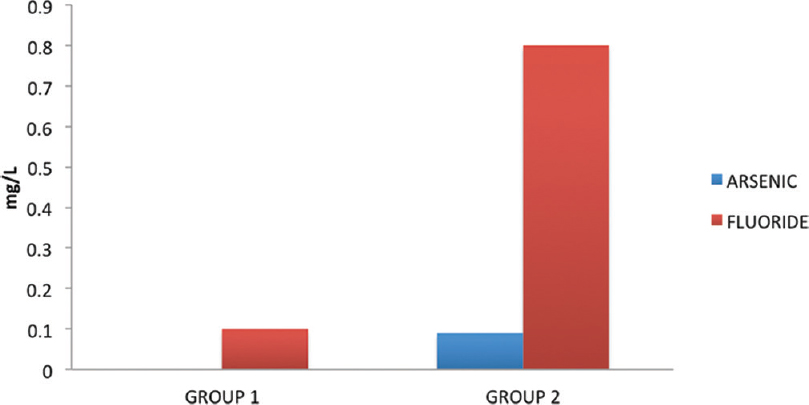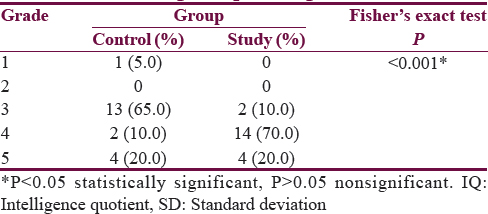Translate this page into:
Environmental Arsenic Contamination and Its Effect on Intelligence Quotient of School Children in a Historic Gold Mining Area Hutti, North Karnataka, India: A Pilot Study
Address for correspondence: Dr. Anisha Keshan, Department of Pedodontics and Preventive Dentistry, A B Shetty Memorial Institute of Dental Sciences, Deralakatte, Mangalore, Karnataka - 575 018, India. E-mail: anishakeshan@gmail.com
This is an open access article distributed under the terms of the Creative Commons Attribution-NonCommercial-ShareAlike 3.0 License, which allows others to remix, tweak, and build upon the work non-commercially, as long as the author is credited and the new creations are licensed under the identical terms.
This article was originally published by Medknow Publications & Media Pvt Ltd and was migrated to Scientific Scholar after the change of Publisher.
Abstract
Context:
Arsenic is a rare crystal element that naturally occurs in all environmental media. A combination of regional and site-specific biogeochemical and hydrological factors governs its dispersion in the environment. It has far reaching consequences on human health. Exposure to arsenic in drinking water has been associated with a decline in intellectual function in children.
Aim:
The aim of this study is to assess the relationship between exposure to arsenic by drinking water and children's intelligence in Karnataka state, India.
Settings and Design:
Twenty school children of age 10–14 years from Sandur, Bellary, Karnataka, and from Hutti, Raichur, Karnataka, were categorized as control and study group, respectively.
Subjects and Methods:
Water samples were collected from both the villages for the analysis of arsenic and fluoride levels. Hair and nail samples were collected from the participants, and the arsenic levels were determined. Intelligence quotient (IQ) assessment was done using the Raven's Standard Progressive Matrices.
Statistical Analysis Used:
Chi-square test, Mann–Whitney U-test, and Fisher's exact test. P < 0.05 was considered statistically significant.
Results:
There was a significant increase in the arsenic content in the hair and nail samples of children in the study group. The mean IQ tests score in the control group and study group was 30.55 and 17.95, respectively, and this difference was statistically significant.
Conclusion:
Chronic arsenic exposure could be a possible cause for the reduced IQ scores seen in children residing in Hutti, Raichur District, North Karnataka.
Keywords
Arsenic
India
intelligence
INTRODUCTION
Arsenic, a ubiquitous element, is ranked first among toxic agents.[1] Around 150 million people are affected by arsenic toxicity in more than 70 countries.[2] In India, groundwater contamination of arsenic is affecting 70 million people.[3] There are 16 affected habitations in Karnataka.[4]
Chronic arsenic exposure causes malignancies, dermatological diseases, and alter cognitive function.[5] According to various epidemiological reports, arsenic exposure can cause a decline in intellectual function in children.[6] However, there is no literature published from the Indian subcontinent. Thus, this study was designed to assess the relationship between exposure to arsenic by drinking water and children's intelligence in Karnataka state, India.
SUBJECTS AND METHODS
This cross-sectional study was conducted among 10–14-year-old school going children of residing in Hutti, Raichur District, North Karnataka and Sandur, Bellary District, North Karnataka. Participation in the study was voluntary. Informed consent for the same was obtained from the parents of the children.
Twenty school children of age 10–14 years from Hutti village were categorized as the study group, and twenty school children from Sandur were categorized as a control. The selected villages were similar in population and general demographic characteristics.
Inclusion criteria for study group
-
Children who were born and brought up in the Hutti village and
-
Children between the ages 10 and 14 years were included in the study group.
Exclusion criteria for study group
-
Children who have recently moved to the village,
-
Children not having water from the common water source, and
-
Children with a history of congenital or acquired neurological disease and/or head injury were excluded from the study group.
Inclusion criteria for control group
-
Children who were born and brought up in Sandur and
-
Children between the ages 10 and 14 years were included in the control group.
Exclusion criteria for control group
-
Children who have recently moved to the village,
-
Children not having water from the common water source, and
-
Children with a history of congenital or acquired neurological disease and/or head injury were excluded from the control group.
A questionnaire, completed with the assistance of parents, was used to collect information on the personal characteristics.
Arsenic levels were assessed in water samples of both the places by atomic absorption spectrometry.[7]
Hair and nail samples were collected from each child, and the arsenic levels were determined using atomic absorption spectrometry[8] and inductively coupled plasma optical emission spectrometry,[9] respectively.
Assessment of intelligence quotient
Children's intelligence quotient (IQ) was measured using the Raven's Standard Progressive Matrices.[10] The children's scores were converted to percentile, and specific grades were allotted based on the following criteria:
-
Grade I: Intellectually superior − if the score lies at or above the ninety-fifth percentile for that age group
-
Grade II: Definitely above average − if the score lies at or above the seventy-fifth percentile for that age group
-
Grade III: Intellectually average − if the score lies between the twenty-fifth and seventy-fifth percentile for that age group
-
Grade IV: Definitely below average in intellectual capacity − if the score lies at or below the twenty-fifth percentile for that age group
-
Grade V: Intellectually impaired − if the score lies at or below the fifth percentile for that age group.
As stated above, the grades and intelligence are inversely related in the Raven's Standard Progressive Matrices.
SPSS v. 17 (SPSS Inc., Chicago, USA) was used for the statistics. Data were statistically analyzed using the Chi-square, Mann–Whitney U-test, and Fisher's exact test. P < 0.05 was considered statistically significant.
RESULTS
The mean age of the children in the control and study group was 11.75 years and 12 years, respectively. Table 1 shows the distribution of children in both groups according to their sex.

The ground water levels of arsenic in Hutti village was found to be 90 μg/L, which is much higher than the WHO standard of 10 μg/L (0.01 ppm), whereas in Sandur, the arsenic level in the ground water was negligible [Figure 1].

- Levels of fluoride and arsenic in the drinking water
Table 2 shows the levels of arsenic in the hair and nail samples of children in both groups. A high statistically significant increase in arsenic levels in the study population was seen (P < 0.001). The distribution of children of both groups according to the IQ grades is shown in Table 3. In control group, the most common IQ grade was grade 3 (65%), whereas in the study group, grade 4 was the most commonly seen IQ grade (70%).


The mean IQ tests score in the control group and study group was 30.55 and 17.95, respectively. This difference in scores was highly statistically significant with P < 0.001 [Table 4].

DISCUSSION
Arsenic, being a normal component of the human body, is transported by the blood to different organs in the body, mainly in the form of monomethyl arsonic acid after ingestion. It causes a variety of adverse health effects to humans after acute and chronic exposures such as dermal changes (pigmentation, hyperkeratoses, and ulceration), respiratory, pulmonary, cardiovascular, gastrointestinal, hematological, hepatic, renal, neurological, developmental, reproductive, immunologic, genotoxic, mutagenic, and carcinogenic effects.[11] All forms of arsenic, including inorganic and methylated arsenicals, accumulate in many parts of the brain, with the highest accumulation in the pituitary.[12]
Contaminated drinking water is the main source of arsenic exposure in humans. In this study also, the ground water levels of arsenic in Hutti village were found to be 90 μg/L, which is much higher than the WHO standard, whereas in the Sandur village taken as control the arsenic level in the ground water was negligible.
In the present study, the mean concentration of arsenic in the study population was found to be 2.44 ppm in the hair samples and 2.72 ppm in the nail samples as compared to 0.12 ppm in both hair and nail samples in the control group. Hindwood et al. found that the concentration of arsenic in hair can be used as a good measurement of chronic exposure.[3] The trivalent inorganic arsenic binds to the SH group of keratin present in the hair and nail.[8] The elevated concentration of arsenic in the hair and nail samples of the study group could be due to the chronic arsenic exposure in the children residing in Hutti village.
This study indicates that exposure to arsenic in drinking water is associated with neurotoxic effects in children. The mean IQ grades of children were significantly lower in children chronically exposed to arsenic in the drinking water in Hutti as compared to the children residing in the control village.
Studies have shown that exposure to lead and arsenic has been associated with a decline in intellectual function in children.[6]
When Wang et al. exposed adult rats to arsenic, the authors found that baby rats developed abnormal nerve construction in the brain cortex and were slower to gain weight compared with normal rats.[6]
Over the past two decades, various epidemiological reports have shown that arsenic exposure may alter cognitive function, particularly learning and memory during childhood.[13] A recently published meta-analysis focused on the impact of arsenic exposure on intelligence measured by IQ tests. Researchers concluded that arsenic exposure was associated with a 0.4 decrease in IQ in exposed children.[14]
CONCLUSION
Significant increase in the arsenic levels in the hair and nail samples were seen in children residing in Hutti, North Karnataka. Arsenic could be a reason for reduced IQ of children in the study group.
Recommendations
IQ assessment should be carried out among a larger sample group. More studies should be carried out in various parts of India where the groundwater is contaminated with arsenic.
Financial support and sponsorship
Nil.
Conflicts of interest
There are no conflicts of interest.
REFERENCES
- Arsenic exposure and toxicology: A historical perspective. Toxicol Sci. 2011;123:305-32.
- [Google Scholar]
- Arsenic exposure and oral cavity lesions in Bangladesh. J Occup Environ Med. 2013;55:59-66.
- [Google Scholar]
- Groundwater Arsenic Contamination in India: Vulnerability and Scope for Remedy. Proceedings of the Workshop on Arsenic Contamination in Groundwater- Source, Migration and Mitigation: Future Research Needs. Kolkata, India: IISWBM; 2010.
- Arsenic Poisoning Water in North Karnataka: CAG. The Times of India; 08 June 2013
- Environmental arsenic contamination and its health effects in a historic gold mining area of the Mangalur greenstone belt of Northeastern Karnataka, India. J Hazard Mater. 2013;262:1048-55.
- [Google Scholar]
- Arsenic and fluoride exposure in drinking water: Children's IQ and growth in Shanyin county, Shanxi province, China. Environ Health Perspect. 2007;115:643-7.
- [Google Scholar]
- Quantitative determination of arsenic in bottled drinking water using atomic absorption spectroscopy. Acta Med Marisiensis. 2013;59:246-9.
- [Google Scholar]
- Hair and toenail arsenic concentrations of residents living in areas with high environmental arsenic concentrations. Environ Health Perspect. 2003;111:187-93.
- [Google Scholar]
- Determination of total arsenic concentrations in nails by inductively coupled plasma mass spectrometry. Biol Trace Elem Res. 1999;67:109-25.
- [Google Scholar]
- Raven Manual: Section 3. The Standard Progressive Matrices. Oxford: Oxford Psychologists Press; 1992.
- The effects of arsenic exposure on neurological and cognitive dysfunction in human and rodent studies: A review. Curr Environ Health Rep. 2014;1:132-47.
- [Google Scholar]
- Association of arsenic, cadmium and manganese exposure with neurodevelopment and behavioural disorders in children: A systematic review and meta-analysis. Sci Total Environ. 2013;454-455:562-77.
- [Google Scholar]
- The association between arsenic and children's intelligence: A meta-analysis. Biol Trace Elem Res. 2009;129:88-93.
- [Google Scholar]






